EPDM97 - A Study on Formative Assessment and its Role in Education
VerifiedAdded on 2023/06/14
|21
|5909
|125
Essay
AI Summary
This essay discusses the role of formative assessments in education, contrasting them with summative assessments and highlighting their importance in enhancing student learning. It reviews the history and evolution of formative assessment practices, emphasizing the benefits of feedback and the integration of assessment into the teaching process. The essay also touches on collaborative activities and teacher observations as key strategies for formative assessment, particularly in the context of foreign language learning. The document emphasizes the need for clear learning goals and the use of various resources to support student understanding. Desklib provides access to this and many other solved assignments for students.
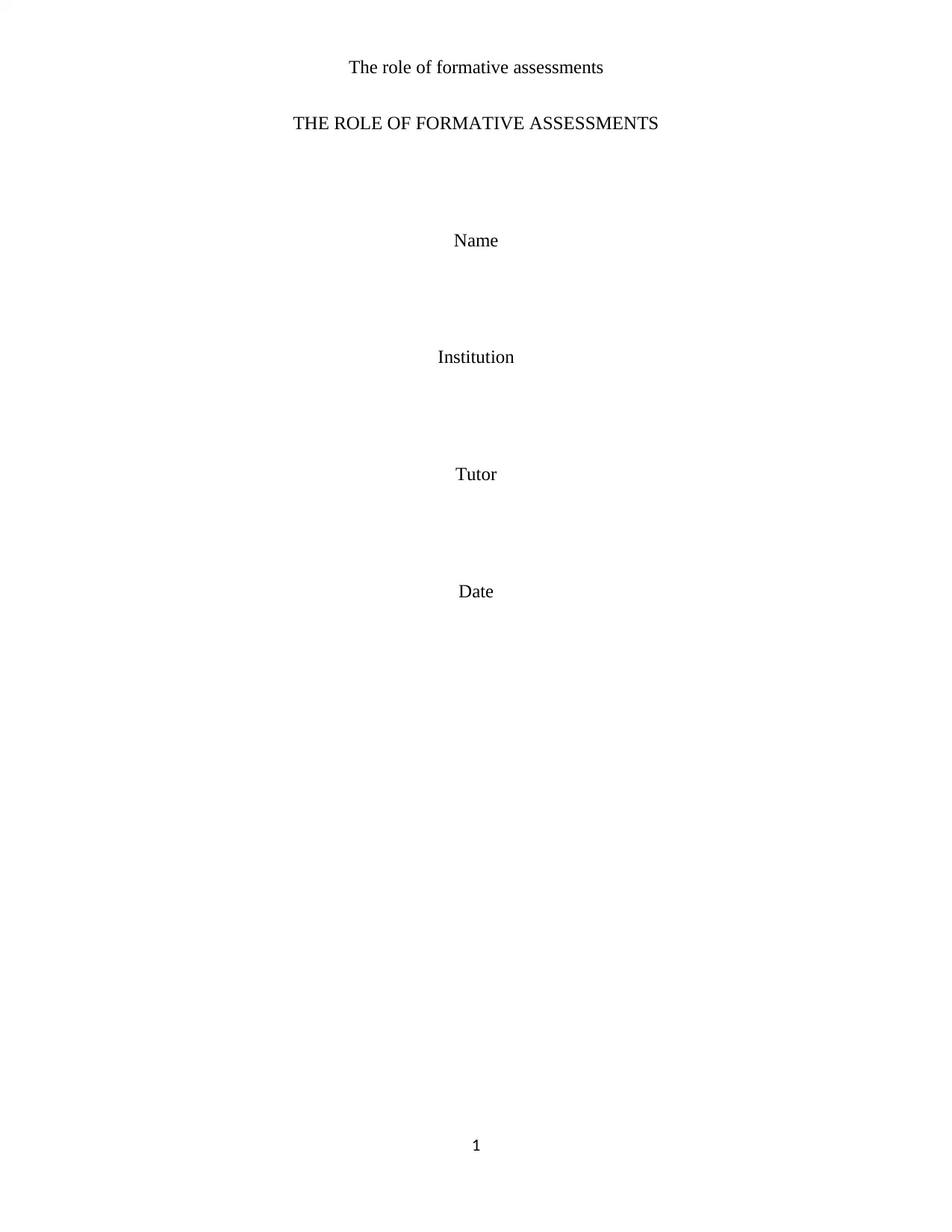
The role of formative assessments
THE ROLE OF FORMATIVE ASSESSMENTS
Name
Institution
Tutor
Date
1
THE ROLE OF FORMATIVE ASSESSMENTS
Name
Institution
Tutor
Date
1
Paraphrase This Document
Need a fresh take? Get an instant paraphrase of this document with our AI Paraphraser
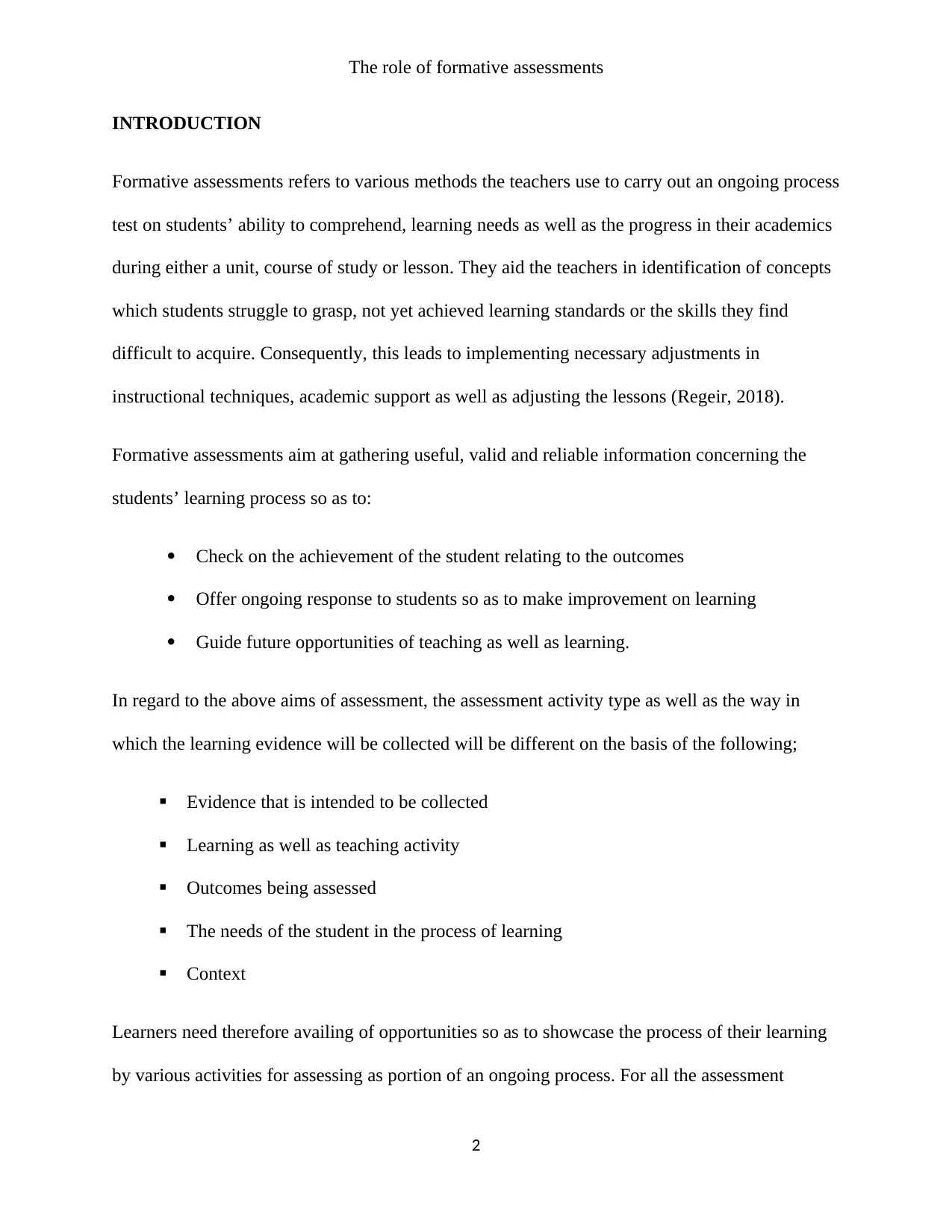
The role of formative assessments
INTRODUCTION
Formative assessments refers to various methods the teachers use to carry out an ongoing process
test on students’ ability to comprehend, learning needs as well as the progress in their academics
during either a unit, course of study or lesson. They aid the teachers in identification of concepts
which students struggle to grasp, not yet achieved learning standards or the skills they find
difficult to acquire. Consequently, this leads to implementing necessary adjustments in
instructional techniques, academic support as well as adjusting the lessons (Regeir, 2018).
Formative assessments aim at gathering useful, valid and reliable information concerning the
students’ learning process so as to:
Check on the achievement of the student relating to the outcomes
Offer ongoing response to students so as to make improvement on learning
Guide future opportunities of teaching as well as learning.
In regard to the above aims of assessment, the assessment activity type as well as the way in
which the learning evidence will be collected will be different on the basis of the following;
Evidence that is intended to be collected
Learning as well as teaching activity
Outcomes being assessed
The needs of the student in the process of learning
Context
Learners need therefore availing of opportunities so as to showcase the process of their learning
by various activities for assessing as portion of an ongoing process. For all the assessment
2
INTRODUCTION
Formative assessments refers to various methods the teachers use to carry out an ongoing process
test on students’ ability to comprehend, learning needs as well as the progress in their academics
during either a unit, course of study or lesson. They aid the teachers in identification of concepts
which students struggle to grasp, not yet achieved learning standards or the skills they find
difficult to acquire. Consequently, this leads to implementing necessary adjustments in
instructional techniques, academic support as well as adjusting the lessons (Regeir, 2018).
Formative assessments aim at gathering useful, valid and reliable information concerning the
students’ learning process so as to:
Check on the achievement of the student relating to the outcomes
Offer ongoing response to students so as to make improvement on learning
Guide future opportunities of teaching as well as learning.
In regard to the above aims of assessment, the assessment activity type as well as the way in
which the learning evidence will be collected will be different on the basis of the following;
Evidence that is intended to be collected
Learning as well as teaching activity
Outcomes being assessed
The needs of the student in the process of learning
Context
Learners need therefore availing of opportunities so as to showcase the process of their learning
by various activities for assessing as portion of an ongoing process. For all the assessment
2
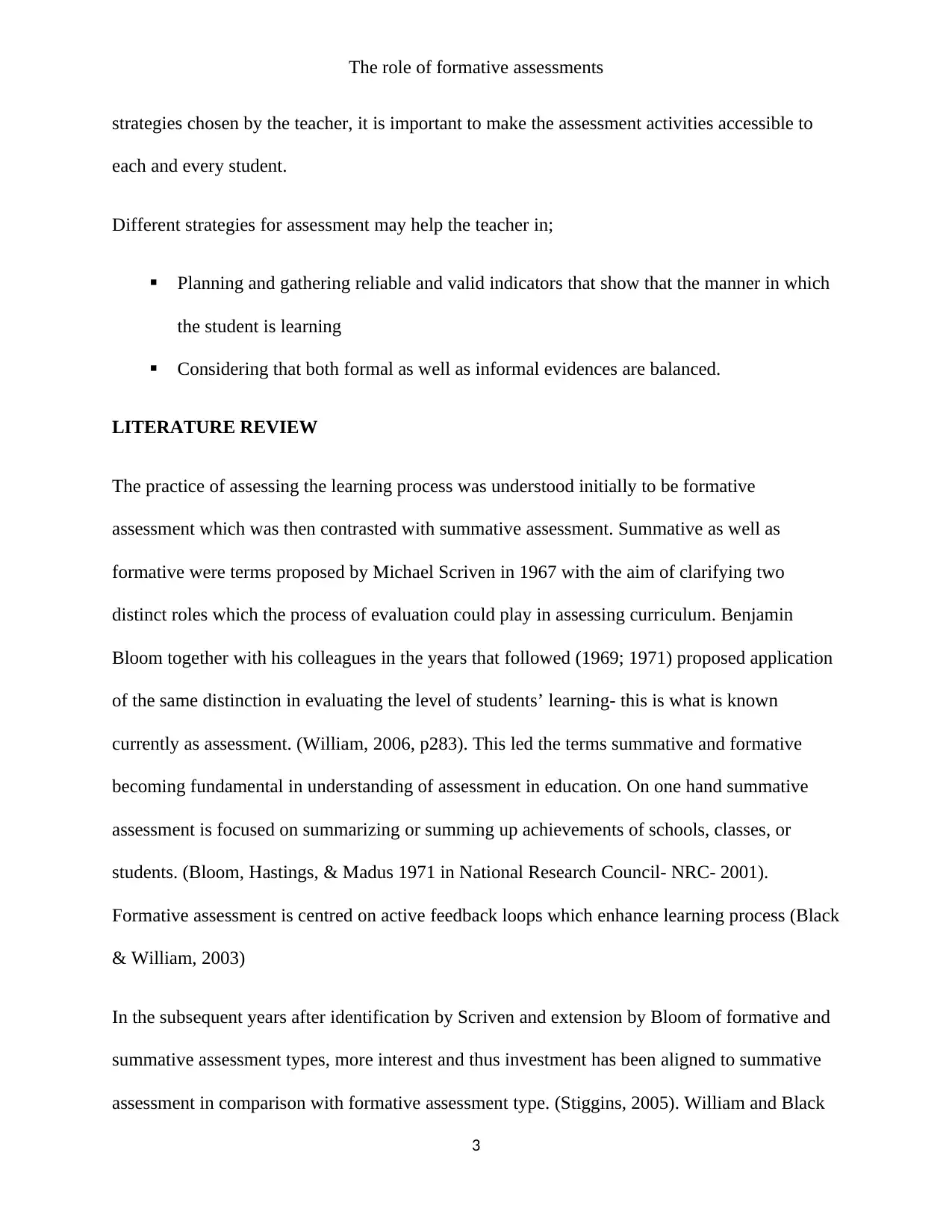
The role of formative assessments
strategies chosen by the teacher, it is important to make the assessment activities accessible to
each and every student.
Different strategies for assessment may help the teacher in;
Planning and gathering reliable and valid indicators that show that the manner in which
the student is learning
Considering that both formal as well as informal evidences are balanced.
LITERATURE REVIEW
The practice of assessing the learning process was understood initially to be formative
assessment which was then contrasted with summative assessment. Summative as well as
formative were terms proposed by Michael Scriven in 1967 with the aim of clarifying two
distinct roles which the process of evaluation could play in assessing curriculum. Benjamin
Bloom together with his colleagues in the years that followed (1969; 1971) proposed application
of the same distinction in evaluating the level of students’ learning- this is what is known
currently as assessment. (William, 2006, p283). This led the terms summative and formative
becoming fundamental in understanding of assessment in education. On one hand summative
assessment is focused on summarizing or summing up achievements of schools, classes, or
students. (Bloom, Hastings, & Madus 1971 in National Research Council- NRC- 2001).
Formative assessment is centred on active feedback loops which enhance learning process (Black
& William, 2003)
In the subsequent years after identification by Scriven and extension by Bloom of formative and
summative assessment types, more interest and thus investment has been aligned to summative
assessment in comparison with formative assessment type. (Stiggins, 2005). William and Black
3
strategies chosen by the teacher, it is important to make the assessment activities accessible to
each and every student.
Different strategies for assessment may help the teacher in;
Planning and gathering reliable and valid indicators that show that the manner in which
the student is learning
Considering that both formal as well as informal evidences are balanced.
LITERATURE REVIEW
The practice of assessing the learning process was understood initially to be formative
assessment which was then contrasted with summative assessment. Summative as well as
formative were terms proposed by Michael Scriven in 1967 with the aim of clarifying two
distinct roles which the process of evaluation could play in assessing curriculum. Benjamin
Bloom together with his colleagues in the years that followed (1969; 1971) proposed application
of the same distinction in evaluating the level of students’ learning- this is what is known
currently as assessment. (William, 2006, p283). This led the terms summative and formative
becoming fundamental in understanding of assessment in education. On one hand summative
assessment is focused on summarizing or summing up achievements of schools, classes, or
students. (Bloom, Hastings, & Madus 1971 in National Research Council- NRC- 2001).
Formative assessment is centred on active feedback loops which enhance learning process (Black
& William, 2003)
In the subsequent years after identification by Scriven and extension by Bloom of formative and
summative assessment types, more interest and thus investment has been aligned to summative
assessment in comparison with formative assessment type. (Stiggins, 2005). William and Black
3
⊘ This is a preview!⊘
Do you want full access?
Subscribe today to unlock all pages.

Trusted by 1+ million students worldwide
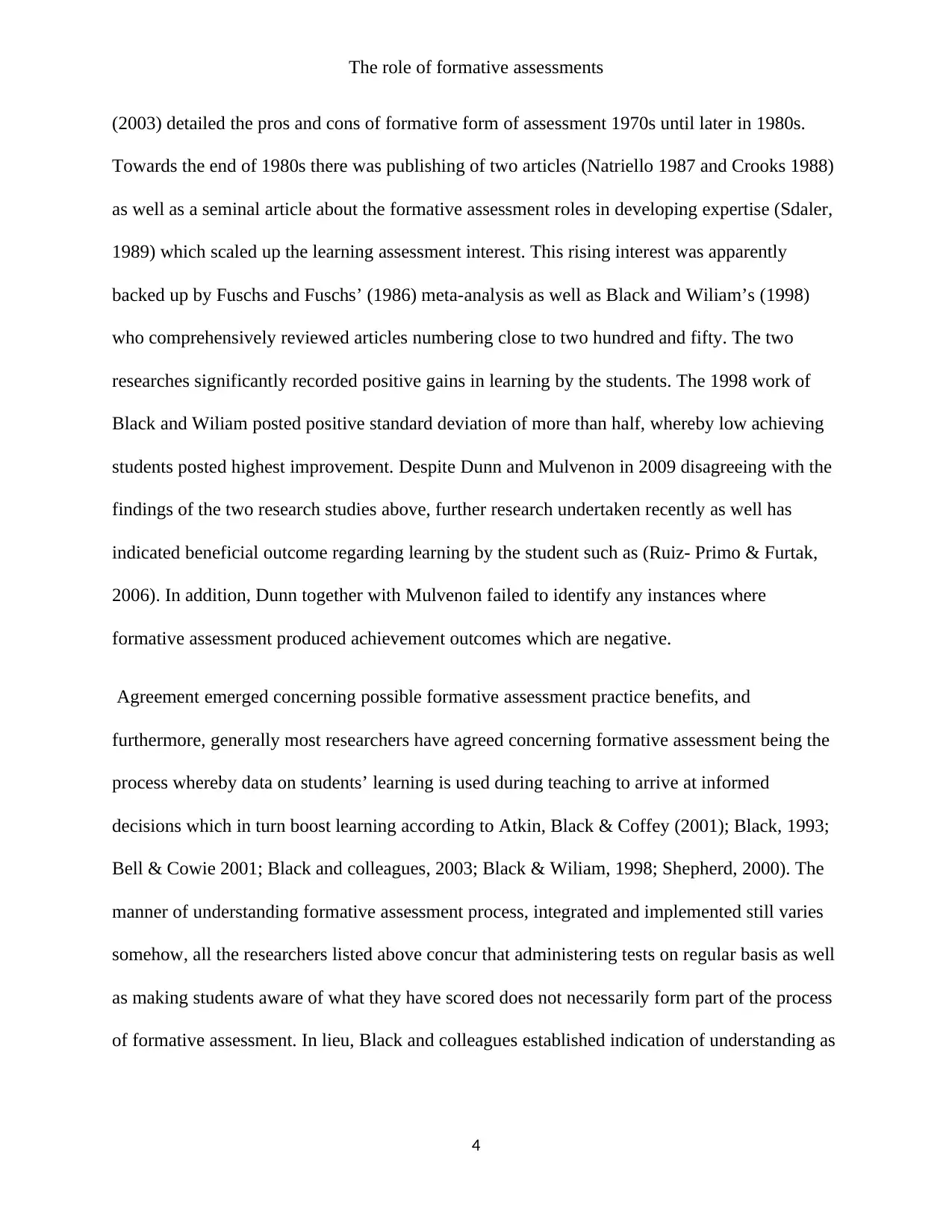
The role of formative assessments
(2003) detailed the pros and cons of formative form of assessment 1970s until later in 1980s.
Towards the end of 1980s there was publishing of two articles (Natriello 1987 and Crooks 1988)
as well as a seminal article about the formative assessment roles in developing expertise (Sdaler,
1989) which scaled up the learning assessment interest. This rising interest was apparently
backed up by Fuschs and Fuschs’ (1986) meta-analysis as well as Black and Wiliam’s (1998)
who comprehensively reviewed articles numbering close to two hundred and fifty. The two
researches significantly recorded positive gains in learning by the students. The 1998 work of
Black and Wiliam posted positive standard deviation of more than half, whereby low achieving
students posted highest improvement. Despite Dunn and Mulvenon in 2009 disagreeing with the
findings of the two research studies above, further research undertaken recently as well has
indicated beneficial outcome regarding learning by the student such as (Ruiz- Primo & Furtak,
2006). In addition, Dunn together with Mulvenon failed to identify any instances where
formative assessment produced achievement outcomes which are negative.
Agreement emerged concerning possible formative assessment practice benefits, and
furthermore, generally most researchers have agreed concerning formative assessment being the
process whereby data on students’ learning is used during teaching to arrive at informed
decisions which in turn boost learning according to Atkin, Black & Coffey (2001); Black, 1993;
Bell & Cowie 2001; Black and colleagues, 2003; Black & Wiliam, 1998; Shepherd, 2000). The
manner of understanding formative assessment process, integrated and implemented still varies
somehow, all the researchers listed above concur that administering tests on regular basis as well
as making students aware of what they have scored does not necessarily form part of the process
of formative assessment. In lieu, Black and colleagues established indication of understanding as
4
(2003) detailed the pros and cons of formative form of assessment 1970s until later in 1980s.
Towards the end of 1980s there was publishing of two articles (Natriello 1987 and Crooks 1988)
as well as a seminal article about the formative assessment roles in developing expertise (Sdaler,
1989) which scaled up the learning assessment interest. This rising interest was apparently
backed up by Fuschs and Fuschs’ (1986) meta-analysis as well as Black and Wiliam’s (1998)
who comprehensively reviewed articles numbering close to two hundred and fifty. The two
researches significantly recorded positive gains in learning by the students. The 1998 work of
Black and Wiliam posted positive standard deviation of more than half, whereby low achieving
students posted highest improvement. Despite Dunn and Mulvenon in 2009 disagreeing with the
findings of the two research studies above, further research undertaken recently as well has
indicated beneficial outcome regarding learning by the student such as (Ruiz- Primo & Furtak,
2006). In addition, Dunn together with Mulvenon failed to identify any instances where
formative assessment produced achievement outcomes which are negative.
Agreement emerged concerning possible formative assessment practice benefits, and
furthermore, generally most researchers have agreed concerning formative assessment being the
process whereby data on students’ learning is used during teaching to arrive at informed
decisions which in turn boost learning according to Atkin, Black & Coffey (2001); Black, 1993;
Bell & Cowie 2001; Black and colleagues, 2003; Black & Wiliam, 1998; Shepherd, 2000). The
manner of understanding formative assessment process, integrated and implemented still varies
somehow, all the researchers listed above concur that administering tests on regular basis as well
as making students aware of what they have scored does not necessarily form part of the process
of formative assessment. In lieu, Black and colleagues established indication of understanding as
4
Paraphrase This Document
Need a fresh take? Get an instant paraphrase of this document with our AI Paraphraser

The role of formative assessments
well as learning by the student gotten from one cycle in formative assessment must be applied to
fit in the work of teaching to address the needs in learning.
Formative Assessment for Students and Teachers State Collaborative (FAST SCASS) which
brought together Chief State Officers comprising of both national and international researchers in
formative assessment in 2007 realized and established five aspects of formative assessment
process in earlier publishing which are;
Indicators-based feedback connected with the desired outcomes of instructions as well as
success criteria must be availed to students
Identification and communication to students concerning goals in learning as well as
success criteria must be clear.
Progressions in learning process must clearly link other goals to the major goal of the
learning
Self- as well as peer-assessments are significant in offering students opportunities to
enable them meta-cognitively think about their acquisition of knowledge and skills.
Establishment of a culture in the classroom that cohesively bring together teachers as
well as students to work hand in hand in the process of learning.
DISCUSSION
This action research (a discourse which seeks to integrate action and knowledge through a
cyclical and participatory process.) focused on the best formative assessment strategies that can
evaluate the level of understanding of foreign language MFL in this case learning of French
language and smooth transition of about 9 Year-6 pupils to secondary level at year 7. It also
5
well as learning by the student gotten from one cycle in formative assessment must be applied to
fit in the work of teaching to address the needs in learning.
Formative Assessment for Students and Teachers State Collaborative (FAST SCASS) which
brought together Chief State Officers comprising of both national and international researchers in
formative assessment in 2007 realized and established five aspects of formative assessment
process in earlier publishing which are;
Indicators-based feedback connected with the desired outcomes of instructions as well as
success criteria must be availed to students
Identification and communication to students concerning goals in learning as well as
success criteria must be clear.
Progressions in learning process must clearly link other goals to the major goal of the
learning
Self- as well as peer-assessments are significant in offering students opportunities to
enable them meta-cognitively think about their acquisition of knowledge and skills.
Establishment of a culture in the classroom that cohesively bring together teachers as
well as students to work hand in hand in the process of learning.
DISCUSSION
This action research (a discourse which seeks to integrate action and knowledge through a
cyclical and participatory process.) focused on the best formative assessment strategies that can
evaluate the level of understanding of foreign language MFL in this case learning of French
language and smooth transition of about 9 Year-6 pupils to secondary level at year 7. It also
5
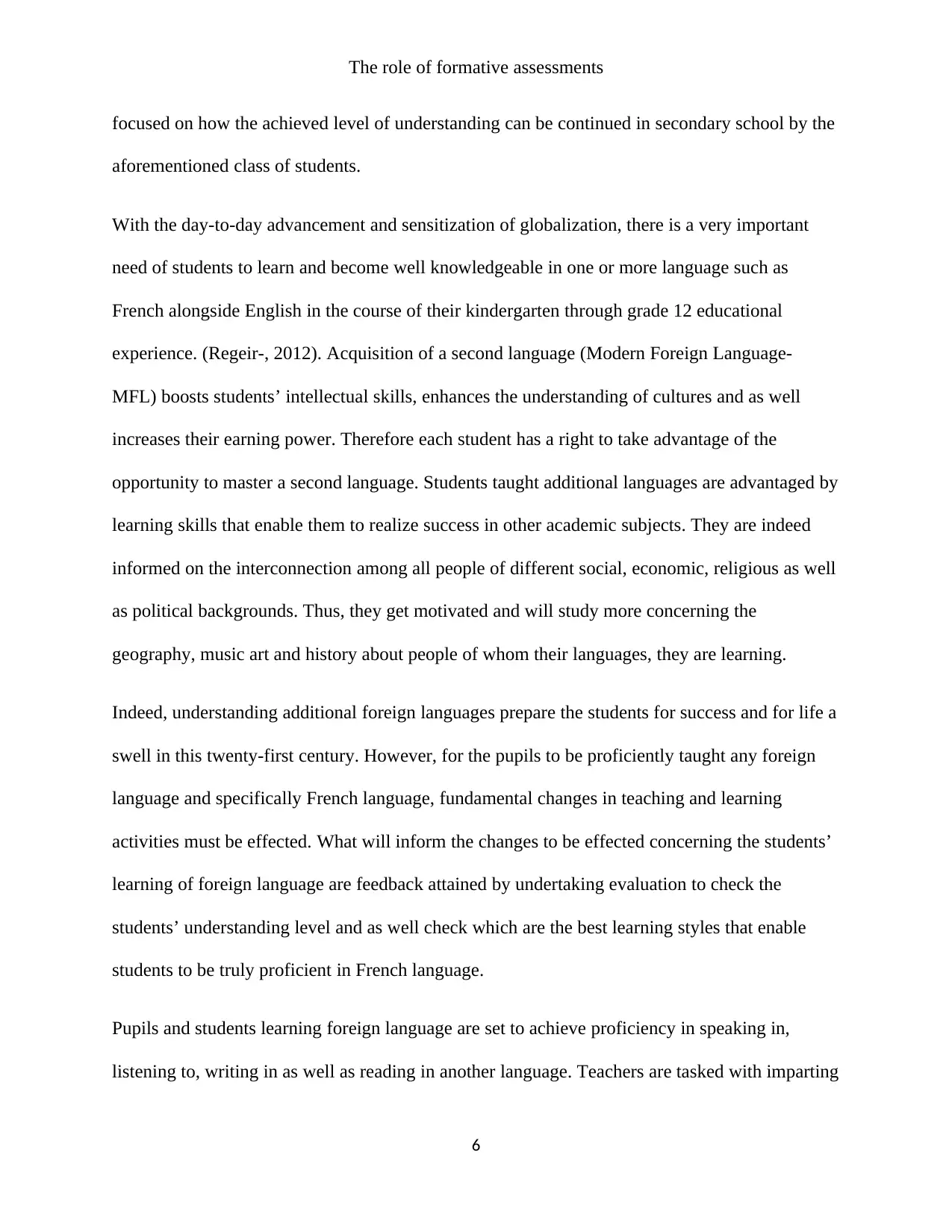
The role of formative assessments
focused on how the achieved level of understanding can be continued in secondary school by the
aforementioned class of students.
With the day-to-day advancement and sensitization of globalization, there is a very important
need of students to learn and become well knowledgeable in one or more language such as
French alongside English in the course of their kindergarten through grade 12 educational
experience. (Regeir-, 2012). Acquisition of a second language (Modern Foreign Language-
MFL) boosts students’ intellectual skills, enhances the understanding of cultures and as well
increases their earning power. Therefore each student has a right to take advantage of the
opportunity to master a second language. Students taught additional languages are advantaged by
learning skills that enable them to realize success in other academic subjects. They are indeed
informed on the interconnection among all people of different social, economic, religious as well
as political backgrounds. Thus, they get motivated and will study more concerning the
geography, music art and history about people of whom their languages, they are learning.
Indeed, understanding additional foreign languages prepare the students for success and for life a
swell in this twenty-first century. However, for the pupils to be proficiently taught any foreign
language and specifically French language, fundamental changes in teaching and learning
activities must be effected. What will inform the changes to be effected concerning the students’
learning of foreign language are feedback attained by undertaking evaluation to check the
students’ understanding level and as well check which are the best learning styles that enable
students to be truly proficient in French language.
Pupils and students learning foreign language are set to achieve proficiency in speaking in,
listening to, writing in as well as reading in another language. Teachers are tasked with imparting
6
focused on how the achieved level of understanding can be continued in secondary school by the
aforementioned class of students.
With the day-to-day advancement and sensitization of globalization, there is a very important
need of students to learn and become well knowledgeable in one or more language such as
French alongside English in the course of their kindergarten through grade 12 educational
experience. (Regeir-, 2012). Acquisition of a second language (Modern Foreign Language-
MFL) boosts students’ intellectual skills, enhances the understanding of cultures and as well
increases their earning power. Therefore each student has a right to take advantage of the
opportunity to master a second language. Students taught additional languages are advantaged by
learning skills that enable them to realize success in other academic subjects. They are indeed
informed on the interconnection among all people of different social, economic, religious as well
as political backgrounds. Thus, they get motivated and will study more concerning the
geography, music art and history about people of whom their languages, they are learning.
Indeed, understanding additional foreign languages prepare the students for success and for life a
swell in this twenty-first century. However, for the pupils to be proficiently taught any foreign
language and specifically French language, fundamental changes in teaching and learning
activities must be effected. What will inform the changes to be effected concerning the students’
learning of foreign language are feedback attained by undertaking evaluation to check the
students’ understanding level and as well check which are the best learning styles that enable
students to be truly proficient in French language.
Pupils and students learning foreign language are set to achieve proficiency in speaking in,
listening to, writing in as well as reading in another language. Teachers are tasked with imparting
6
⊘ This is a preview!⊘
Do you want full access?
Subscribe today to unlock all pages.

Trusted by 1+ million students worldwide
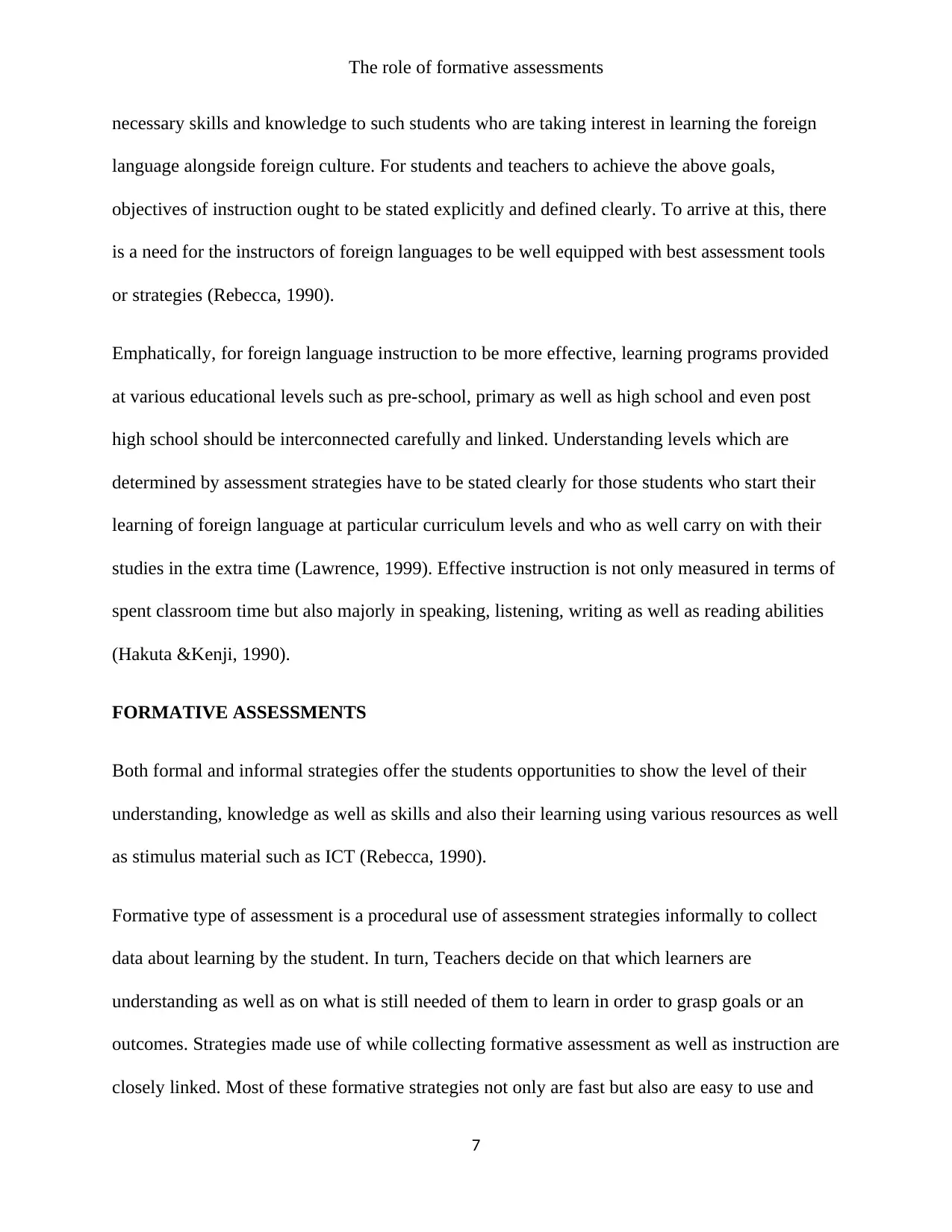
The role of formative assessments
necessary skills and knowledge to such students who are taking interest in learning the foreign
language alongside foreign culture. For students and teachers to achieve the above goals,
objectives of instruction ought to be stated explicitly and defined clearly. To arrive at this, there
is a need for the instructors of foreign languages to be well equipped with best assessment tools
or strategies (Rebecca, 1990).
Emphatically, for foreign language instruction to be more effective, learning programs provided
at various educational levels such as pre-school, primary as well as high school and even post
high school should be interconnected carefully and linked. Understanding levels which are
determined by assessment strategies have to be stated clearly for those students who start their
learning of foreign language at particular curriculum levels and who as well carry on with their
studies in the extra time (Lawrence, 1999). Effective instruction is not only measured in terms of
spent classroom time but also majorly in speaking, listening, writing as well as reading abilities
(Hakuta &Kenji, 1990).
FORMATIVE ASSESSMENTS
Both formal and informal strategies offer the students opportunities to show the level of their
understanding, knowledge as well as skills and also their learning using various resources as well
as stimulus material such as ICT (Rebecca, 1990).
Formative type of assessment is a procedural use of assessment strategies informally to collect
data about learning by the student. In turn, Teachers decide on that which learners are
understanding as well as on what is still needed of them to learn in order to grasp goals or an
outcomes. Strategies made use of while collecting formative assessment as well as instruction are
closely linked. Most of these formative strategies not only are fast but also are easy to use and
7
necessary skills and knowledge to such students who are taking interest in learning the foreign
language alongside foreign culture. For students and teachers to achieve the above goals,
objectives of instruction ought to be stated explicitly and defined clearly. To arrive at this, there
is a need for the instructors of foreign languages to be well equipped with best assessment tools
or strategies (Rebecca, 1990).
Emphatically, for foreign language instruction to be more effective, learning programs provided
at various educational levels such as pre-school, primary as well as high school and even post
high school should be interconnected carefully and linked. Understanding levels which are
determined by assessment strategies have to be stated clearly for those students who start their
learning of foreign language at particular curriculum levels and who as well carry on with their
studies in the extra time (Lawrence, 1999). Effective instruction is not only measured in terms of
spent classroom time but also majorly in speaking, listening, writing as well as reading abilities
(Hakuta &Kenji, 1990).
FORMATIVE ASSESSMENTS
Both formal and informal strategies offer the students opportunities to show the level of their
understanding, knowledge as well as skills and also their learning using various resources as well
as stimulus material such as ICT (Rebecca, 1990).
Formative type of assessment is a procedural use of assessment strategies informally to collect
data about learning by the student. In turn, Teachers decide on that which learners are
understanding as well as on what is still needed of them to learn in order to grasp goals or an
outcomes. Strategies made use of while collecting formative assessment as well as instruction are
closely linked. Most of these formative strategies not only are fast but also are easy to use and
7
Paraphrase This Document
Need a fresh take? Get an instant paraphrase of this document with our AI Paraphraser
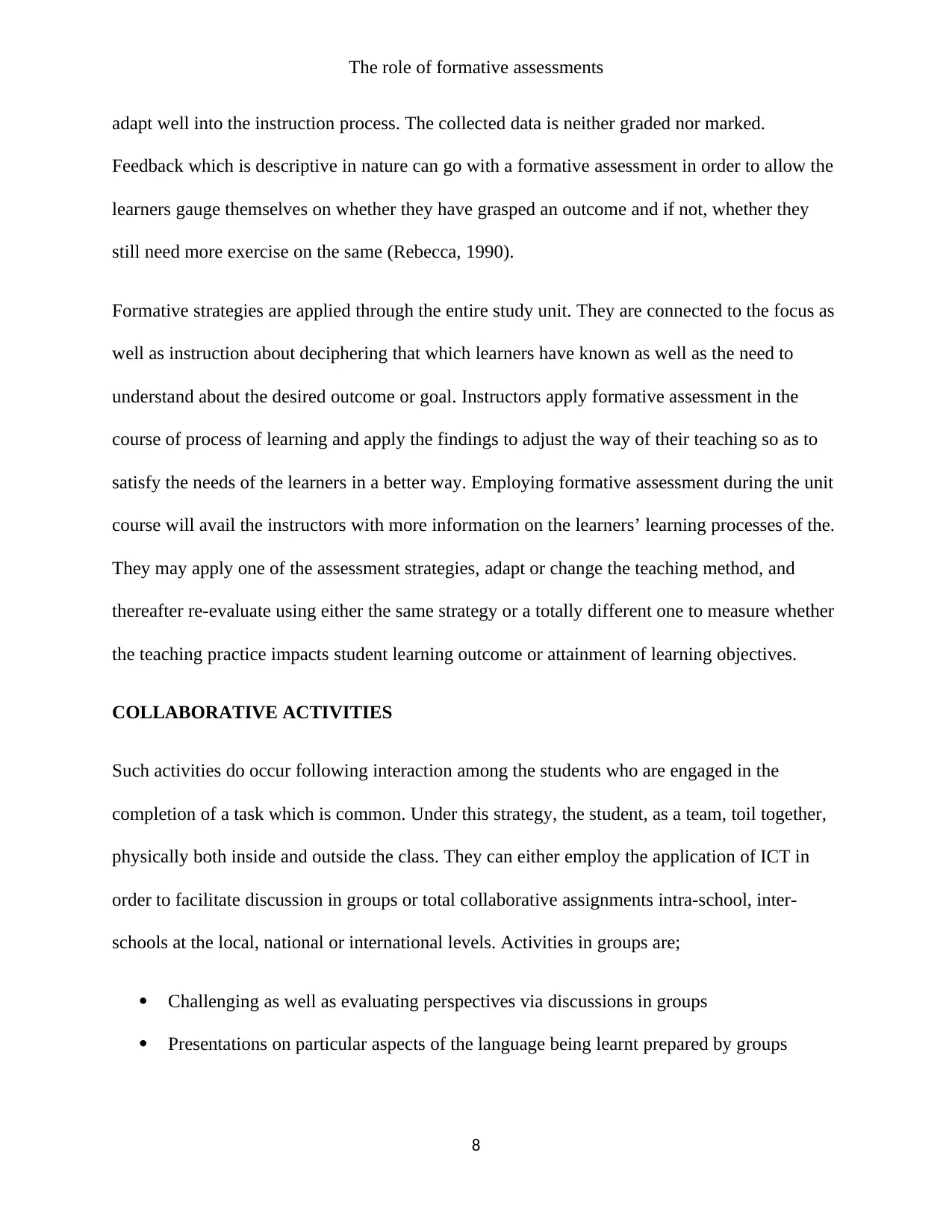
The role of formative assessments
adapt well into the instruction process. The collected data is neither graded nor marked.
Feedback which is descriptive in nature can go with a formative assessment in order to allow the
learners gauge themselves on whether they have grasped an outcome and if not, whether they
still need more exercise on the same (Rebecca, 1990).
Formative strategies are applied through the entire study unit. They are connected to the focus as
well as instruction about deciphering that which learners have known as well as the need to
understand about the desired outcome or goal. Instructors apply formative assessment in the
course of process of learning and apply the findings to adjust the way of their teaching so as to
satisfy the needs of the learners in a better way. Employing formative assessment during the unit
course will avail the instructors with more information on the learners’ learning processes of the.
They may apply one of the assessment strategies, adapt or change the teaching method, and
thereafter re-evaluate using either the same strategy or a totally different one to measure whether
the teaching practice impacts student learning outcome or attainment of learning objectives.
COLLABORATIVE ACTIVITIES
Such activities do occur following interaction among the students who are engaged in the
completion of a task which is common. Under this strategy, the student, as a team, toil together,
physically both inside and outside the class. They can either employ the application of ICT in
order to facilitate discussion in groups or total collaborative assignments intra-school, inter-
schools at the local, national or international levels. Activities in groups are;
Challenging as well as evaluating perspectives via discussions in groups
Presentations on particular aspects of the language being learnt prepared by groups
8
adapt well into the instruction process. The collected data is neither graded nor marked.
Feedback which is descriptive in nature can go with a formative assessment in order to allow the
learners gauge themselves on whether they have grasped an outcome and if not, whether they
still need more exercise on the same (Rebecca, 1990).
Formative strategies are applied through the entire study unit. They are connected to the focus as
well as instruction about deciphering that which learners have known as well as the need to
understand about the desired outcome or goal. Instructors apply formative assessment in the
course of process of learning and apply the findings to adjust the way of their teaching so as to
satisfy the needs of the learners in a better way. Employing formative assessment during the unit
course will avail the instructors with more information on the learners’ learning processes of the.
They may apply one of the assessment strategies, adapt or change the teaching method, and
thereafter re-evaluate using either the same strategy or a totally different one to measure whether
the teaching practice impacts student learning outcome or attainment of learning objectives.
COLLABORATIVE ACTIVITIES
Such activities do occur following interaction among the students who are engaged in the
completion of a task which is common. Under this strategy, the student, as a team, toil together,
physically both inside and outside the class. They can either employ the application of ICT in
order to facilitate discussion in groups or total collaborative assignments intra-school, inter-
schools at the local, national or international levels. Activities in groups are;
Challenging as well as evaluating perspectives via discussions in groups
Presentations on particular aspects of the language being learnt prepared by groups
8
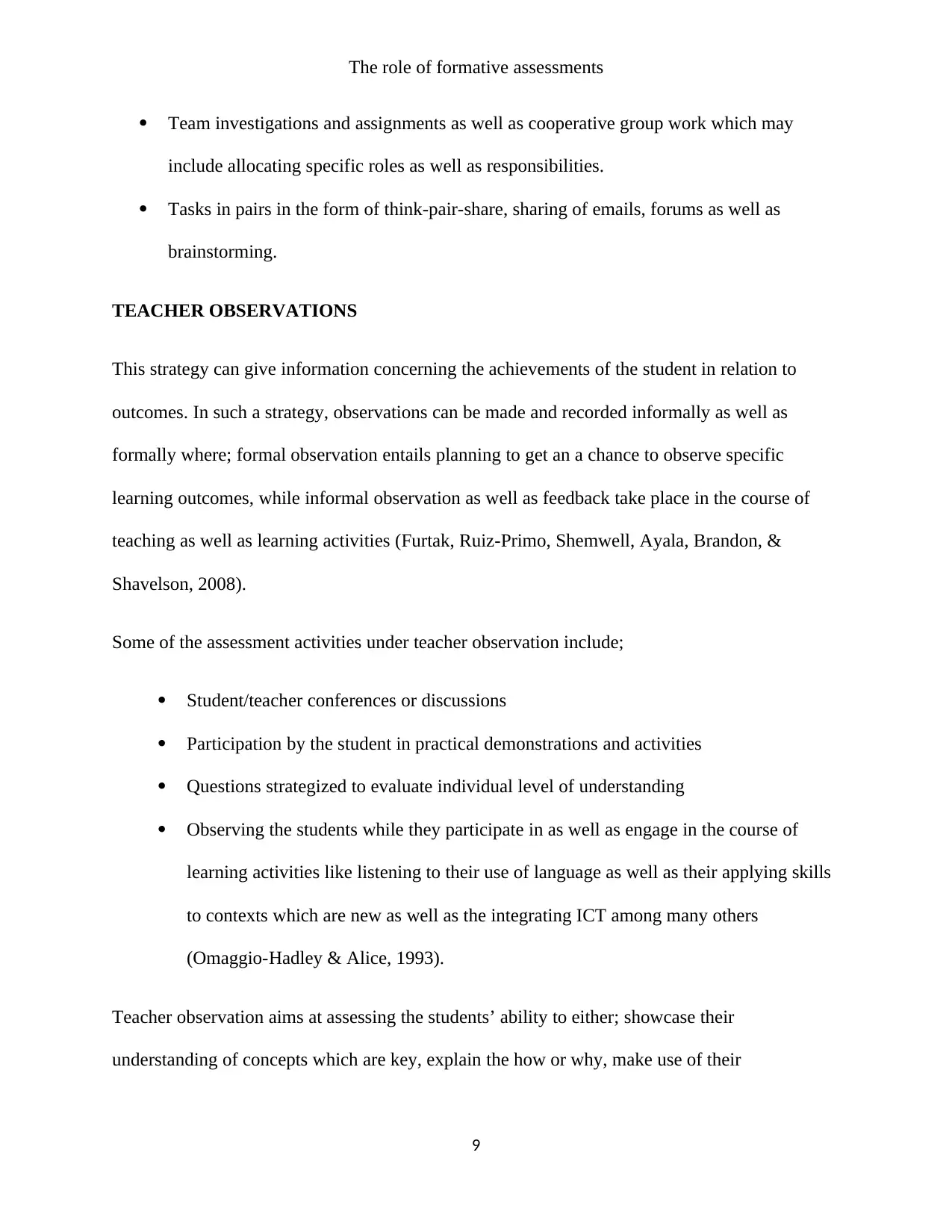
The role of formative assessments
Team investigations and assignments as well as cooperative group work which may
include allocating specific roles as well as responsibilities.
Tasks in pairs in the form of think-pair-share, sharing of emails, forums as well as
brainstorming.
TEACHER OBSERVATIONS
This strategy can give information concerning the achievements of the student in relation to
outcomes. In such a strategy, observations can be made and recorded informally as well as
formally where; formal observation entails planning to get an a chance to observe specific
learning outcomes, while informal observation as well as feedback take place in the course of
teaching as well as learning activities (Furtak, Ruiz-Primo, Shemwell, Ayala, Brandon, &
Shavelson, 2008).
Some of the assessment activities under teacher observation include;
Student/teacher conferences or discussions
Participation by the student in practical demonstrations and activities
Questions strategized to evaluate individual level of understanding
Observing the students while they participate in as well as engage in the course of
learning activities like listening to their use of language as well as their applying skills
to contexts which are new as well as the integrating ICT among many others
(Omaggio-Hadley & Alice, 1993).
Teacher observation aims at assessing the students’ ability to either; showcase their
understanding of concepts which are key, explain the how or why, make use of their
9
Team investigations and assignments as well as cooperative group work which may
include allocating specific roles as well as responsibilities.
Tasks in pairs in the form of think-pair-share, sharing of emails, forums as well as
brainstorming.
TEACHER OBSERVATIONS
This strategy can give information concerning the achievements of the student in relation to
outcomes. In such a strategy, observations can be made and recorded informally as well as
formally where; formal observation entails planning to get an a chance to observe specific
learning outcomes, while informal observation as well as feedback take place in the course of
teaching as well as learning activities (Furtak, Ruiz-Primo, Shemwell, Ayala, Brandon, &
Shavelson, 2008).
Some of the assessment activities under teacher observation include;
Student/teacher conferences or discussions
Participation by the student in practical demonstrations and activities
Questions strategized to evaluate individual level of understanding
Observing the students while they participate in as well as engage in the course of
learning activities like listening to their use of language as well as their applying skills
to contexts which are new as well as the integrating ICT among many others
(Omaggio-Hadley & Alice, 1993).
Teacher observation aims at assessing the students’ ability to either; showcase their
understanding of concepts which are key, explain the how or why, make use of their
9
⊘ This is a preview!⊘
Do you want full access?
Subscribe today to unlock all pages.

Trusted by 1+ million students worldwide
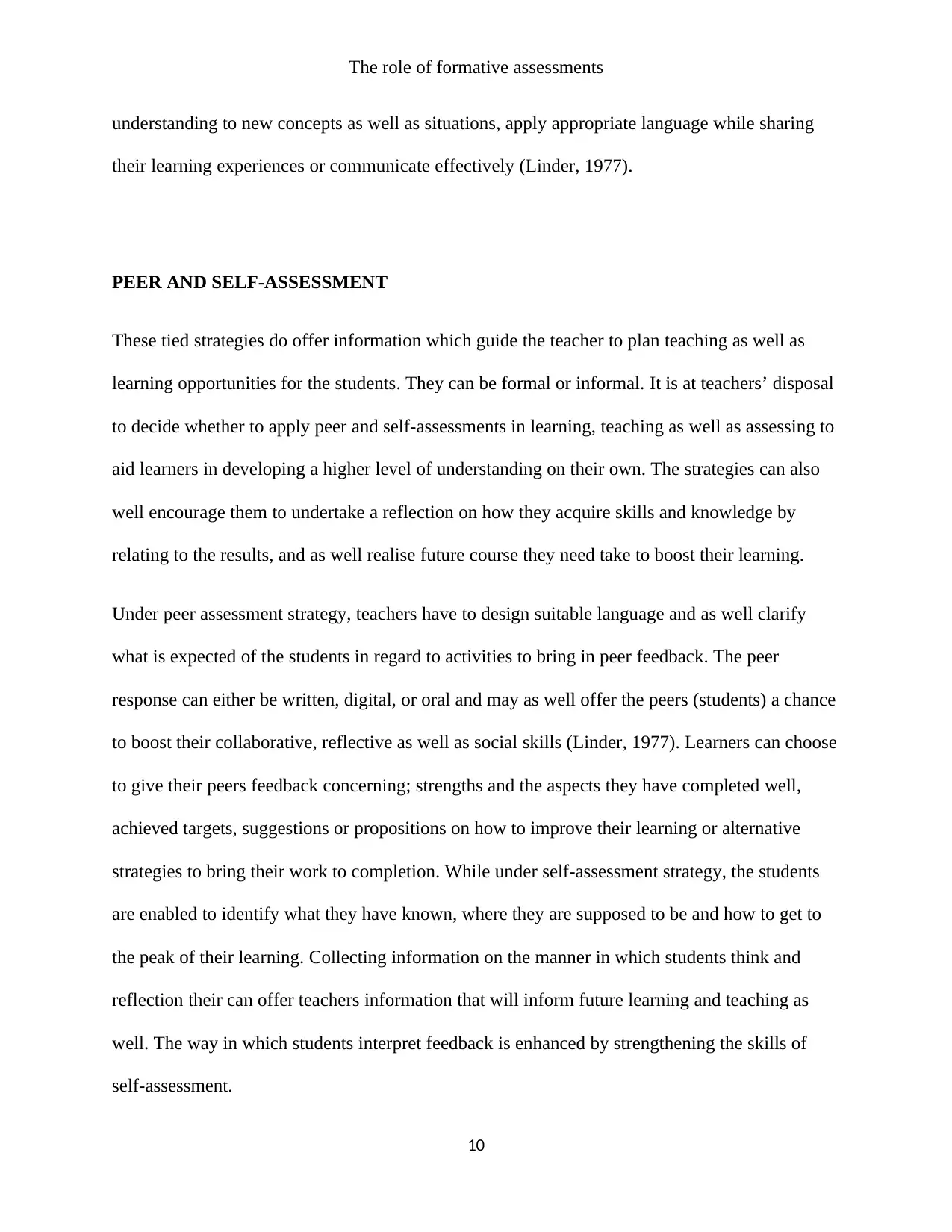
The role of formative assessments
understanding to new concepts as well as situations, apply appropriate language while sharing
their learning experiences or communicate effectively (Linder, 1977).
PEER AND SELF-ASSESSMENT
These tied strategies do offer information which guide the teacher to plan teaching as well as
learning opportunities for the students. They can be formal or informal. It is at teachers’ disposal
to decide whether to apply peer and self-assessments in learning, teaching as well as assessing to
aid learners in developing a higher level of understanding on their own. The strategies can also
well encourage them to undertake a reflection on how they acquire skills and knowledge by
relating to the results, and as well realise future course they need take to boost their learning.
Under peer assessment strategy, teachers have to design suitable language and as well clarify
what is expected of the students in regard to activities to bring in peer feedback. The peer
response can either be written, digital, or oral and may as well offer the peers (students) a chance
to boost their collaborative, reflective as well as social skills (Linder, 1977). Learners can choose
to give their peers feedback concerning; strengths and the aspects they have completed well,
achieved targets, suggestions or propositions on how to improve their learning or alternative
strategies to bring their work to completion. While under self-assessment strategy, the students
are enabled to identify what they have known, where they are supposed to be and how to get to
the peak of their learning. Collecting information on the manner in which students think and
reflection their can offer teachers information that will inform future learning and teaching as
well. The way in which students interpret feedback is enhanced by strengthening the skills of
self-assessment.
10
understanding to new concepts as well as situations, apply appropriate language while sharing
their learning experiences or communicate effectively (Linder, 1977).
PEER AND SELF-ASSESSMENT
These tied strategies do offer information which guide the teacher to plan teaching as well as
learning opportunities for the students. They can be formal or informal. It is at teachers’ disposal
to decide whether to apply peer and self-assessments in learning, teaching as well as assessing to
aid learners in developing a higher level of understanding on their own. The strategies can also
well encourage them to undertake a reflection on how they acquire skills and knowledge by
relating to the results, and as well realise future course they need take to boost their learning.
Under peer assessment strategy, teachers have to design suitable language and as well clarify
what is expected of the students in regard to activities to bring in peer feedback. The peer
response can either be written, digital, or oral and may as well offer the peers (students) a chance
to boost their collaborative, reflective as well as social skills (Linder, 1977). Learners can choose
to give their peers feedback concerning; strengths and the aspects they have completed well,
achieved targets, suggestions or propositions on how to improve their learning or alternative
strategies to bring their work to completion. While under self-assessment strategy, the students
are enabled to identify what they have known, where they are supposed to be and how to get to
the peak of their learning. Collecting information on the manner in which students think and
reflection their can offer teachers information that will inform future learning and teaching as
well. The way in which students interpret feedback is enhanced by strengthening the skills of
self-assessment.
10
Paraphrase This Document
Need a fresh take? Get an instant paraphrase of this document with our AI Paraphraser
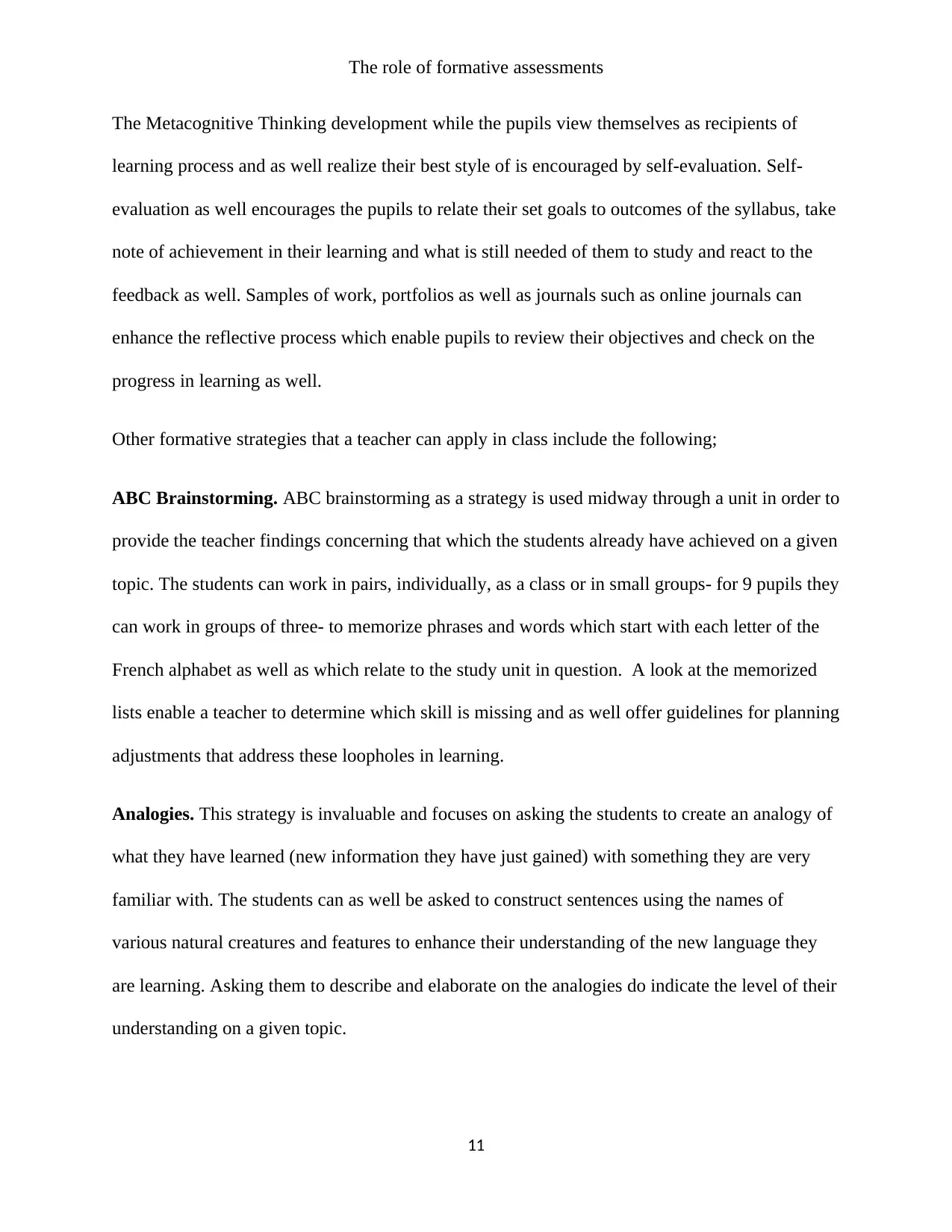
The role of formative assessments
The Metacognitive Thinking development while the pupils view themselves as recipients of
learning process and as well realize their best style of is encouraged by self-evaluation. Self-
evaluation as well encourages the pupils to relate their set goals to outcomes of the syllabus, take
note of achievement in their learning and what is still needed of them to study and react to the
feedback as well. Samples of work, portfolios as well as journals such as online journals can
enhance the reflective process which enable pupils to review their objectives and check on the
progress in learning as well.
Other formative strategies that a teacher can apply in class include the following;
ABC Brainstorming. ABC brainstorming as a strategy is used midway through a unit in order to
provide the teacher findings concerning that which the students already have achieved on a given
topic. The students can work in pairs, individually, as a class or in small groups- for 9 pupils they
can work in groups of three- to memorize phrases and words which start with each letter of the
French alphabet as well as which relate to the study unit in question. A look at the memorized
lists enable a teacher to determine which skill is missing and as well offer guidelines for planning
adjustments that address these loopholes in learning.
Analogies. This strategy is invaluable and focuses on asking the students to create an analogy of
what they have learned (new information they have just gained) with something they are very
familiar with. The students can as well be asked to construct sentences using the names of
various natural creatures and features to enhance their understanding of the new language they
are learning. Asking them to describe and elaborate on the analogies do indicate the level of their
understanding on a given topic.
11
The Metacognitive Thinking development while the pupils view themselves as recipients of
learning process and as well realize their best style of is encouraged by self-evaluation. Self-
evaluation as well encourages the pupils to relate their set goals to outcomes of the syllabus, take
note of achievement in their learning and what is still needed of them to study and react to the
feedback as well. Samples of work, portfolios as well as journals such as online journals can
enhance the reflective process which enable pupils to review their objectives and check on the
progress in learning as well.
Other formative strategies that a teacher can apply in class include the following;
ABC Brainstorming. ABC brainstorming as a strategy is used midway through a unit in order to
provide the teacher findings concerning that which the students already have achieved on a given
topic. The students can work in pairs, individually, as a class or in small groups- for 9 pupils they
can work in groups of three- to memorize phrases and words which start with each letter of the
French alphabet as well as which relate to the study unit in question. A look at the memorized
lists enable a teacher to determine which skill is missing and as well offer guidelines for planning
adjustments that address these loopholes in learning.
Analogies. This strategy is invaluable and focuses on asking the students to create an analogy of
what they have learned (new information they have just gained) with something they are very
familiar with. The students can as well be asked to construct sentences using the names of
various natural creatures and features to enhance their understanding of the new language they
are learning. Asking them to describe and elaborate on the analogies do indicate the level of their
understanding on a given topic.
11
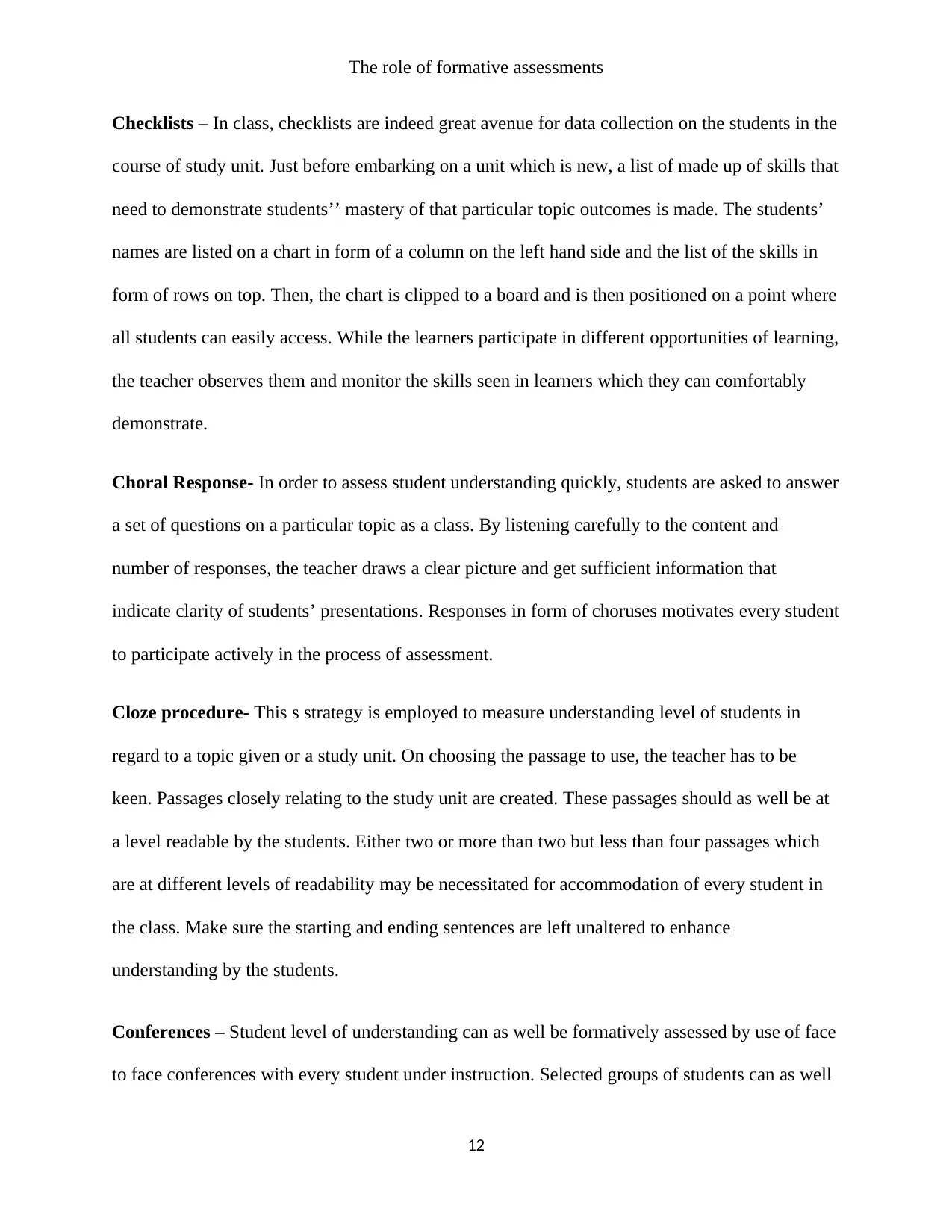
The role of formative assessments
Checklists – In class, checklists are indeed great avenue for data collection on the students in the
course of study unit. Just before embarking on a unit which is new, a list of made up of skills that
need to demonstrate students’’ mastery of that particular topic outcomes is made. The students’
names are listed on a chart in form of a column on the left hand side and the list of the skills in
form of rows on top. Then, the chart is clipped to a board and is then positioned on a point where
all students can easily access. While the learners participate in different opportunities of learning,
the teacher observes them and monitor the skills seen in learners which they can comfortably
demonstrate.
Choral Response- In order to assess student understanding quickly, students are asked to answer
a set of questions on a particular topic as a class. By listening carefully to the content and
number of responses, the teacher draws a clear picture and get sufficient information that
indicate clarity of students’ presentations. Responses in form of choruses motivates every student
to participate actively in the process of assessment.
Cloze procedure- This s strategy is employed to measure understanding level of students in
regard to a topic given or a study unit. On choosing the passage to use, the teacher has to be
keen. Passages closely relating to the study unit are created. These passages should as well be at
a level readable by the students. Either two or more than two but less than four passages which
are at different levels of readability may be necessitated for accommodation of every student in
the class. Make sure the starting and ending sentences are left unaltered to enhance
understanding by the students.
Conferences – Student level of understanding can as well be formatively assessed by use of face
to face conferences with every student under instruction. Selected groups of students can as well
12
Checklists – In class, checklists are indeed great avenue for data collection on the students in the
course of study unit. Just before embarking on a unit which is new, a list of made up of skills that
need to demonstrate students’’ mastery of that particular topic outcomes is made. The students’
names are listed on a chart in form of a column on the left hand side and the list of the skills in
form of rows on top. Then, the chart is clipped to a board and is then positioned on a point where
all students can easily access. While the learners participate in different opportunities of learning,
the teacher observes them and monitor the skills seen in learners which they can comfortably
demonstrate.
Choral Response- In order to assess student understanding quickly, students are asked to answer
a set of questions on a particular topic as a class. By listening carefully to the content and
number of responses, the teacher draws a clear picture and get sufficient information that
indicate clarity of students’ presentations. Responses in form of choruses motivates every student
to participate actively in the process of assessment.
Cloze procedure- This s strategy is employed to measure understanding level of students in
regard to a topic given or a study unit. On choosing the passage to use, the teacher has to be
keen. Passages closely relating to the study unit are created. These passages should as well be at
a level readable by the students. Either two or more than two but less than four passages which
are at different levels of readability may be necessitated for accommodation of every student in
the class. Make sure the starting and ending sentences are left unaltered to enhance
understanding by the students.
Conferences – Student level of understanding can as well be formatively assessed by use of face
to face conferences with every student under instruction. Selected groups of students can as well
12
⊘ This is a preview!⊘
Do you want full access?
Subscribe today to unlock all pages.

Trusted by 1+ million students worldwide
1 out of 21
Related Documents
Your All-in-One AI-Powered Toolkit for Academic Success.
+13062052269
info@desklib.com
Available 24*7 on WhatsApp / Email
![[object Object]](/_next/static/media/star-bottom.7253800d.svg)
Unlock your academic potential
Copyright © 2020–2025 A2Z Services. All Rights Reserved. Developed and managed by ZUCOL.



